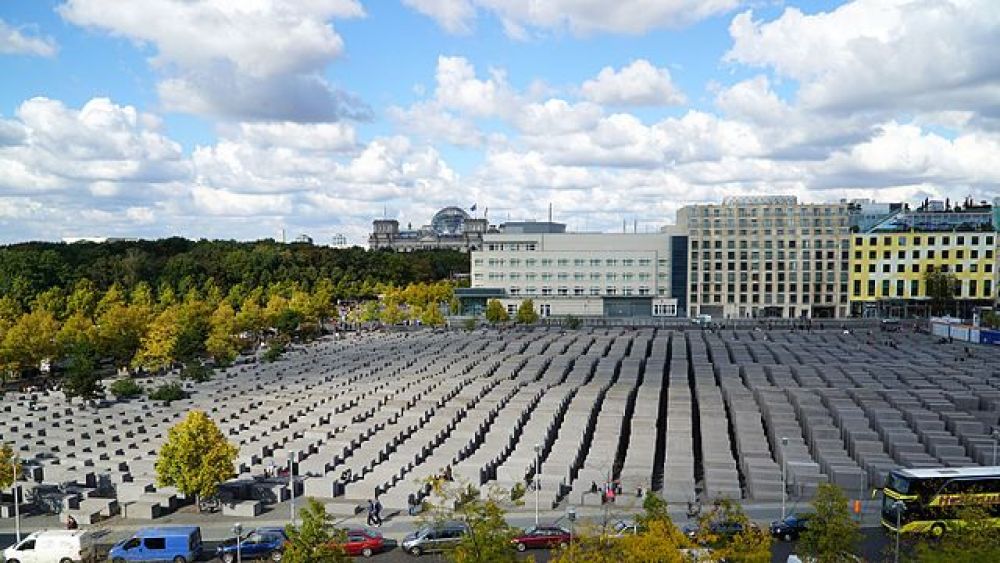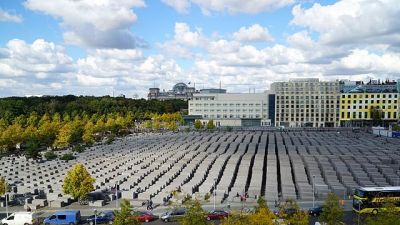

The Holocaust Memorial, also known as The Memorial to the Murdered Jews of Europe, is a poignant and powerful landmark in the heart of Berlin. Designed by architect Peter Eisenman and engineer Buro Happold, it consists of 2,711 concrete slabs arranged in a grid pattern on a sloping field. As visitors walk through the stelae, the uneven ground and the varying heights of the blocks create a disorienting, claustrophobic atmosphere that serves as a powerful symbol of the chaos and suffering of the victims of the Holocaust. This self-guided tour allows visitors to reflect on the memorial's significance at their own pace. Interpretive signs provide context about the memorial and the history it commemorates. Suitable for individuals, families, and groups, the self-guided tour is a sobering reminder of the atrocities of the Holocaust and a tribute to its victims.
Explore the depths of the Holocaust Memorial with an expert guide who will illuminate the site's history, architectural significance, and the memory culture surrounding the events of the Holocaust. The tour typically includes a visit to the underground Information Centre located beneath the field of stelae, where personal stories of the victims and their families are presented. Through photographs, diaries, and letters, visitors gain a deeper understanding of the individuals affected by the Holocaust. The guide will provide historical context and answer your questions, enriching the experience and providing a more comprehensive understanding of the significance of the memorial to both Berlin and the world. Educational and moving, this guided tour ensures a profound engagement with this solemn tribute.
This walking tour provides a broader context to the history of Berlin during the Third Reich and World War II. Led by an experienced guide, the itinerary covers key historical sites including the Brandenburg Gate, the former site of Hitler's Bunker, and the Holocaust Memorial. As visitors move between landmarks, the guide shares insights into Nazi Germany, the experiences of the Jewish community, and the impact of the war on the city. The tour at the Holocaust Memorial is particularly poignant as guests are invited to contemplate the meaning of the memorial's design and to understand the stories of the individuals commemorated there. This comprehensive tour offers a meaningful look at Berlin's dark past and the steps taken to remember and honor those who suffered.
For those with an interest in photography, this specialized tour offers an opportunity to capture the stark beauty and emotional impact of the Holocaust Memorial through the lens of a camera. Under the guidance of a professional photographer, participants will learn how to use light, shadow, and composition to photograph the memorial in a respectful and powerful way. The photographer will offer tips on how to convey the solemnity of the site and its historical significance through imagery. This tour not only encourages creative expression but also deepens the participants' connection to the memorial and its role in remembrance culture. Suitable for amateur and experienced photographers alike, participants can expect to leave with a collection of impactful images and a heightened understanding of the memorial's place in history.
A nighttime visit to the Holocaust Memorial offers a different perspective on this evocative landmark. As the shadows lengthen and the city quietens, the memorial takes on an even more somber and reflective atmosphere. This self-directed experience allows visitors to wander through the ghostly rows of stelae under the moon and stars, inviting contemplation on the memorial's significance in the silence of the night. There are no formal tours during this time, but the experience of being at the memorial after dark can be profound and moving. Visitors are reminded to be respectful of the site and its commemorative purpose at all times, but a nighttime visit can provide a unique and memorable encounter with this important piece of history.
The Holocaust Memorial offers specialized educational programs tailored to school groups of various ages. These programs facilitate understanding of the Holocaust through interactive workshops, guided tours, and discussions led by experienced educators. The aim is to help students comprehend the magnitude of the Holocaust and the importance of remembering its victims, all within the context of the memorial's poignant symbolism. By engaging with the site, students are encouraged to reflect on themes of tolerance, human rights, and the consequences of hate. These programs often include a visit to the Information Centre, where students can learn about individual stories of the Holocaust through exhibits and personal testimonies. The educational program is an invaluable resource for teachers looking to provide their students with a deeper understanding of this tragic chapter in history.
For those who wish to explore the Holocaust Memorial at their own pace but would like some guidance, the audio guide tour is an ideal option. Available in multiple languages, the audio guide provides detailed narratives about the design and significance of the memorial, as well as historical context regarding the Holocaust. As visitors wander through the towering columns and the Information Centre, the audio guide enriches the experience with stories, facts, and explanatory content. This self-paced tour is a convenient way to gain insight into the memorial while remaining flexible to the visitor's personal schedule and interest areas. Earphones are generally provided, or visitors may be able to use their own devices to access the guide.
Delve into the architectural significance of the Holocaust Memorial with a thematic seminar led by architects or scholars specializing in memorial design. Participants will gain an in-depth understanding of Peter Eisenman's vision in creating a space that evokes feelings of isolation and disorientation—symbolic of the experiences of Holocaust victims. The seminar typically includes a lecture, a guided tour of the memorial, and discussions on how architecture can serve as a vehicle for memory and education. Additionally, aspects of contemporary memorial design and its challenges are often explored, prompting participants to consider how architecture shapes public perception and memory of historical events. This seminar is perfect for those with a keen interest in architecture, design, and the ways in which they intersect with history and collective memory.
Throughout the year, the Holocaust Memorial hosts various commemorative ceremonies to honor the memory of the victims of the Holocaust. These events typically involve speeches, moments of silence, wreath-laying activities, and other acts of remembrance. Participation in a commemorative ceremony can be a deeply moving and poignant experience, as it allows individuals to join in collective reflection and mourning. The specific dates and nature of these ceremonies vary, often aligning with significant dates such as International Holocaust Remembrance Day or the anniversary of the liberation of Auschwitz concentration camp. Visitors are welcomed to join these ceremonies, which offer a shared space for contemplation, respect, and a commitment to never forget the past.
The multi-media guide at the Holocaust Memorial provides an interactive and engaging way to understand the complex history of the site and the events it commemorates. This technology-driven tour includes audio, video, and photographic content that deepens visitors' engagement with the Memorial to the Murdered Jews of Europe. Utilizing a hand-held device, visitors can select different themes, such as personal stories, historical events, and the memorial's design, to tailor the experience to their interests. The multi-media guide is particularly appealing to those who appreciate a technologically enriched learning environment and offers an alternative to traditional guided tours.
